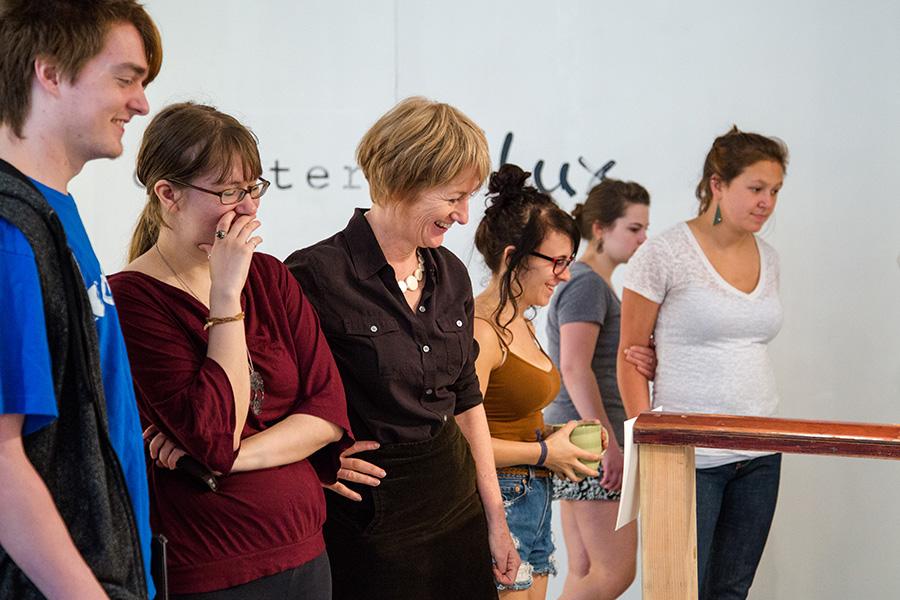Art & Art History Degrees and Areas of Study
Majors
Areas of Study

Art History at Western Washington University is focused on undergraduate education. Each of our faculty members holds a Ph.D., and create a rigorous and thorough curriculum, which they instruct. Your classroom experiences are shaped and directed by their dedication and continuing growth as scholars and leaders in their respective areas.
Jimena Berzal de Dios
Early modern European art and architecture; critical theory and phenomenology
Monique Kerman
African art and visual culture; 20th and 21st century art of the African diaspora; feminist and post-colonial theory
Barbara L. Miller
visual culture, gender studies, modern art, and contemporary art, film and new media
Julia Sapin
Pacific, Asian and Northwest Coast art and visual culture and cross-cultural studies
The Art Studio B.A. (Bachelor of Arts) and B.F.A. (Bachelor of Fine Arts) degree programs provide a broad foundation in art practice, history, and theory that emphasizes experimentation, creative problem solving, critical thinking, and global awareness. Interaction with a faculty of practicing artists, visiting artists, professional and student exhibitions, international study, as well as the resources of the larger university, foster informed, engaged, and creative graduates, preparing them for professional careers and graduate studies.
Art Studio B.A. students develop an individual plan of study that encourages exploration and specialization in one or more studio practices, including ceramics, drawing/painting, fiber/fabrics, mixed media, photography, printmaking, time-based art, sculpture, and courses in professional development and Art History. The Art Studio B.F.A. is a selective expanded program focused on the year-long development of a professional body of work, culminating in a Western Gallery exhibition and catalog.
Studio BA Learning Outcomes
- Broad experience in the foundations of studio art, with some specialization in studio art practices.
- Understanding of the formal visual relationships present in the art and design process.
- Critical thinking about the relationship of art practice to culture, community and place.
- Broad knowledge of global visual art culture and history.
- Awareness of career opportunities in art and related fields, and competency to independently seek further professional growth.
- The development of artist statements, professional resumes and image portfolios.
Studio BFA Learning Outcomes
- The development of a professional body of work, culminating in a Western Gallery exhibition and catalog.
- Experience with materials and process in an intensive self-directed studio process.
- Self-discipline, time management and competence in the techniques and skills needed to further ideas and to complete projects.
- Knowledge of sources, ideas, subject matter and contemporary practice relevant to projects; expanded conceptual understanding and critical thinking.
- Experience creating promotional materials, planning, and installing an exhibition collaboratively as a group and individually.
- The ability to begin to operate as a professional artist at the local, regional, or national level, and preparedness for graduate study.
The Art Education major must be accompanied by the professional preparation program in secondary education.
Programs in art education lead to becoming either an elementary classroom teacher or an art specialist who teaches art only. Elementary classroom teachers, who teach all subjects, must specialize in one area by completing the 50-credit program in addition to those courses specified in the elementary education section of this catalog. Students who want to teach art only at any grade level take the 71-credit program. Courses required for a state teaching endorsement must be completed with a grade of C (2.0) or better.
A formal course plan must be developed with the area coordinator by the time a student completes 12 art credits. Refer to the Art Education course plans for more detailed information. Transfer students with more than 18 credits of art should do this prior to completion of their second quarter at the University. Once developed, the course plan is placed on file in the art office. Students are strongly encouraged to complete the studio and Art History requirements prior to completing the art education series.
Art Education Contact
For advising about Art Education, please email artinfo@wwu.edu, or call 360-650-3660.
Need more info?
For advising and information about the Department of Art & Art History, email us or call 360-650-3660.
